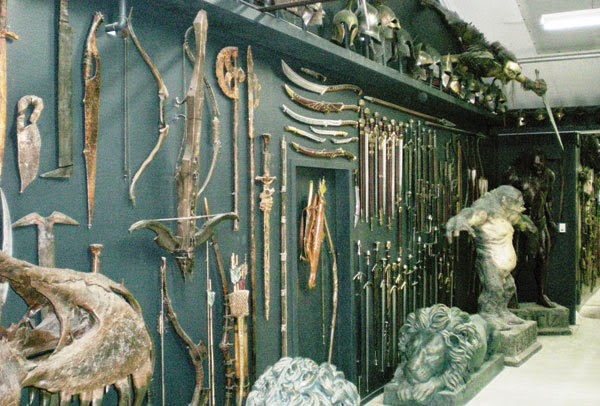It
is almost essential for epic Sci-Fi stories to have races of aliens. It is
equally essential that these alien cultures have a well-developed culture or
their existence seems frivolous and flat or even fake. But which franchise does
it better? Trek or Wars?
Developing cultures of alien species is something Star Trek excels at. The most well known are the Vulcans, who seek to live by reason and logic alone with no emotional interference. There are the Klingons, a gruff warrior race. The Ferengi who obsess over trade and profit. The Borg function as a hive-mind and seek to assimilate others to their ranks.
 Each of these Star Trek species are unique. They hail from different planet and
have unique languages. They have specific abilities, rituals and symbols. They
are well-developed, even down to their mating habits, and many having existed in
the Star Trek universe for almost 50 years.
Each of these Star Trek species are unique. They hail from different planet and
have unique languages. They have specific abilities, rituals and symbols. They
are well-developed, even down to their mating habits, and many having existed in
the Star Trek universe for almost 50 years. 
The culture which has gone through the most developing and changing is undoubtedly the Klingons. The species originated in the 60s. They were portrayed by white actors who covered their faces in bronze shoe-polish. Some people thought they represented a prejudice view of the Japanese culture in a time when World War II was still fresh in the minds of Americans.
It
wasn’t until 1979 that Klingons got face-ridges, sharp-teeth, and their very own
language. The language was developed by Marc Okrand, an American linguist who
wanted to make it unique. It purposely betrays many common traits of spoken
languages on Earth including the fact that it has no “ah” sound. The devotion
Trekkies have to the Klingon language is actually pretty phenomenal. There is
an opera entirely in Klingon called “Klingon Christmas Carol”, Shakespeare has
been translated to Klingon, even parts of the bible have been translated to
Klingon. There are a few dozen fluent speakers worldwide.
One could try and make a case that the Star Wars alien cultures and languages are also fairly fleshed out. The Hutts, for example have their own language, Huttese. Like the Ewok language it was based on a real dying tribal language. But its hard to take a language seriously when one of the curse words is “Poodoo”.
The
sad truth is that the Star Wars cultures are not developed as well as the Star
Trek ones. You don’t learn much about wookiees by looking at Chewbacca. He is
loyal and often angry and wears a bandoleer full of ammunition pouches. Yet
beyond the fact that it is unwise to upset a Wookiee, we don’t know much about
them. It’s not that we need to have Chewbacca flashbacks that show his native
land and people, we just need some kind of items, clothing, or props that gives
the audience some clues to who he is, where he comes from.
 |
| WETA Workshop |
Let’s be honest, Lucasfilm is no WETA. When watching Lord of the Rings you
subconsciously pick up hundreds of traits from the Hobbits, Elves, Dwarves, and
Orcs in every single frame. There are some Star Wars species that get this kind
of focus but unfortunately they are Ewoks and Gungans.
 Many Star Wars races are just too
simplistic. The Hutts are evil crime lords. The Nemodians are evil merchants
that speak in Chinese accents. The Tusken Raiders are wandering violent desert
folk and are probably an allegory for Arabs. The Ewoks are simple forest-beings
with little understanding of technology. The Gungans are weird fish things that
appeal to 4-year-olds. Can we really compare any of these cultures to Star Trek
or Lord of the Rings or the Wizard World of Harry Potter. There is little
complexity in Star Wars cultures because many are designed with preschoolers in
mind.
Many Star Wars races are just too
simplistic. The Hutts are evil crime lords. The Nemodians are evil merchants
that speak in Chinese accents. The Tusken Raiders are wandering violent desert
folk and are probably an allegory for Arabs. The Ewoks are simple forest-beings
with little understanding of technology. The Gungans are weird fish things that
appeal to 4-year-olds. Can we really compare any of these cultures to Star Trek
or Lord of the Rings or the Wizard World of Harry Potter. There is little
complexity in Star Wars cultures because many are designed with preschoolers in
mind. |
| Klingon Opera |
Today's
winner is STAR TREK. Here is the score sheet so far.
Score
so far:
Round
1 -Aliens & Robots (Star Wars)
Round
2 -Human Characters (Star Trek)
Round
3 -Action (Star Wars)
Round
4 -Science (Star Trek)
Round
5 –Planets (Star Wars)
Round 6 – Cultures and Languages (Star Trek)
Round 6 – Cultures and Languages (Star Trek)
Overall
Score:
Star
Wars = 3
Star
Trek = 3




No comments:
Post a Comment